engine coolant JEEP PATRIOT 2020 Owner handbook (in English)
[x] Cancel search | Manufacturer: JEEP, Model Year: 2020, Model line: PATRIOT, Model: JEEP PATRIOT 2020Pages: 332, PDF Size: 1.99 MB
Page 269 of 332
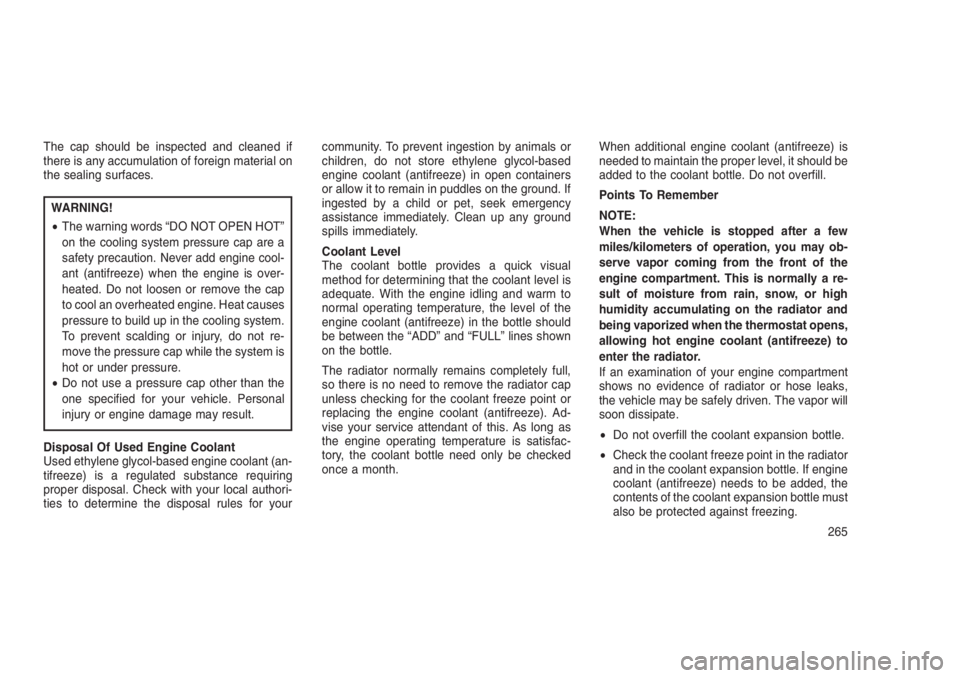
The cap should be inspected and cleaned if
there is any accumulation of foreign material on
the sealing surfaces.
WARNING!
•The warning words “DO NOT OPEN HOT”
on the cooling system pressure cap are a
safety precaution. Never add engine cool-
ant (antifreeze) when the engine is over-
heated. Do not loosen or remove the cap
to cool an overheated engine. Heat causes
pressure to build up in the cooling system.
To prevent scalding or injury, do not re-
move the pressure cap while the system is
hot or under pressure.
•Do not use a pressure cap other than the
one specified for your vehicle. Personal
injury or engine damage may result.
Disposal Of Used Engine Coolant
Used ethylene glycol-based engine coolant (an-
tifreeze) is a regulated substance requiring
proper disposal. Check with your local authori-
ties to determine the disposal rules for yourcommunity. To prevent ingestion by animals or
children, do not store ethylene glycol-based
engine coolant (antifreeze) in open containers
or allow it to remain in puddles on the ground. If
ingested by a child or pet, seek emergency
assistance immediately. Clean up any ground
spills immediately.
Coolant Level
The coolant bottle provides a quick visual
method for determining that the coolant level is
adequate. With the engine idling and warm to
normal operating temperature, the level of the
engine coolant (antifreeze) in the bottle should
be between the “ADD” and “FULL” lines shown
on the bottle.
The radiator normally remains completely full,
so there is no need to remove the radiator cap
unless checking for the coolant freeze point or
replacing the engine coolant (antifreeze). Ad-
vise your service attendant of this. As long as
the engine operating temperature is satisfac-
tory, the coolant bottle need only be checked
once a month.When additional engine coolant (antifreeze) is
needed to maintain the proper level, it should be
added to the coolant bottle. Do not overfill.
Points To Remember
NOTE:
When the vehicle is stopped after a few
miles/kilometers of operation, you may ob-
serve vapor coming from the front of the
engine compartment. This is normally a re-
sult of moisture from rain, snow, or high
humidity accumulating on the radiator and
being vaporized when the thermostat opens,
allowing hot engine coolant (antifreeze) to
enter the radiator.
If an examination of your engine compartment
shows no evidence of radiator or hose leaks,
the vehicle may be safely driven. The vapor will
soon dissipate.
•Do not overfill the coolant expansion bottle.
•Check the coolant freeze point in the radiator
and in the coolant expansion bottle. If engine
coolant (antifreeze) needs to be added, the
contents of the coolant expansion bottle must
also be protected against freezing.
265
Page 270 of 332
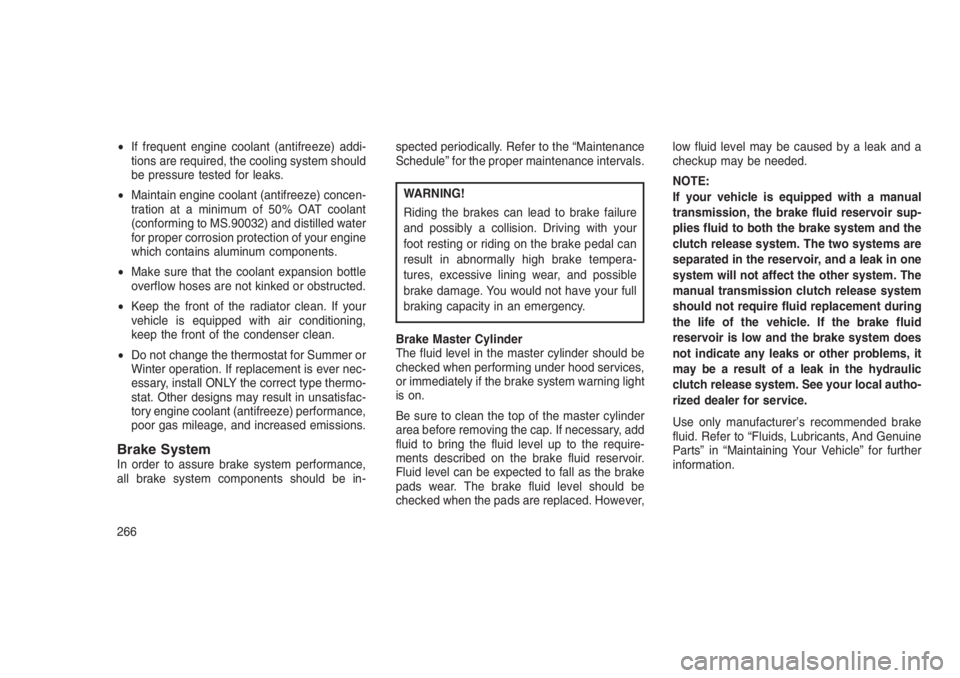
•If frequent engine coolant (antifreeze) addi-
tions are required, the cooling system should
be pressure tested for leaks.
•Maintain engine coolant (antifreeze) concen-
tration at a minimum of 50% OAT coolant
(conforming to MS.90032) and distilled water
for proper corrosion protection of your engine
which contains aluminum components.
•Make sure that the coolant expansion bottle
overflow hoses are not kinked or obstructed.
•Keep the front of the radiator clean. If your
vehicle is equipped with air conditioning,
keep the front of the condenser clean.
•Do not change the thermostat for Summer or
Winter operation. If replacement is ever nec-
essary, install ONLY the correct type thermo-
stat. Other designs may result in unsatisfac-
tory engine coolant (antifreeze) performance,
poor gas mileage, and increased emissions.
Brake SystemIn order to assure brake system performance,
all brake system components should be in-spected periodically. Refer to the “Maintenance
Schedule” for the proper maintenance intervals.
WARNING!
Riding the brakes can lead to brake failure
and possibly a collision. Driving with your
foot resting or riding on the brake pedal can
result in abnormally high brake tempera-
tures, excessive lining wear, and possible
brake damage. You would not have your full
braking capacity in an emergency.
Brake Master Cylinder
The fluid level in the master cylinder should be
checked when performing under hood services,
or immediately if the brake system warning light
is on.
Be sure to clean the top of the master cylinder
area before removing the cap. If necessary, add
fluid to bring the fluid level up to the require-
ments described on the brake fluid reservoir.
Fluid level can be expected to fall as the brake
pads wear. The brake fluid level should be
checked when the pads are replaced. However,low fluid level may be caused by a leak and a
checkup may be needed.
NOTE:
If your vehicle is equipped with a manual
transmission, the brake fluid reservoir sup-
plies fluid to both the brake system and the
clutch release system. The two systems are
separated in the reservoir, and a leak in one
system will not affect the other system. The
manual transmission clutch release system
should not require fluid replacement during
the life of the vehicle. If the brake fluid
reservoir is low and the brake system does
not indicate any leaks or other problems, it
may be a result of a leak in the hydraulic
clutch release system. See your local autho-
rized dealer for service.
Use only manufacturer’s recommended brake
fluid. Refer to “Fluids, Lubricants, And Genuine
Parts” in “Maintaining Your Vehicle” for further
information.
266
Page 284 of 332
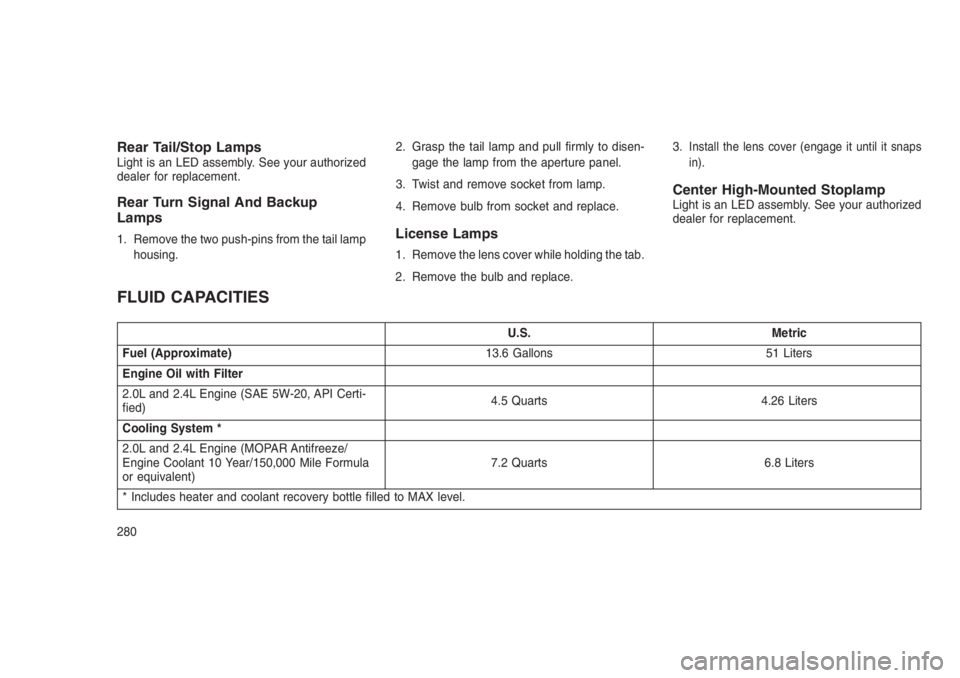
Rear Tail/Stop LampsLight is an LED assembly. See your authorized
dealer for replacement.
Rear Turn Signal And Backup
Lamps
1. Remove the two push-pins from the tail lamp
housing.2. Grasp the tail lamp and pull firmly to disen-
gage the lamp from the aperture panel.
3. Twist and remove socket from lamp.
4. Remove bulb from socket and replace.License Lamps
1. Remove the lens cover while holding the tab.
2. Remove the bulb and replace.3.
Install the lens cover (engage it until it snaps
in).
Center High-Mounted StoplampLight is an LED assembly. See your authorized
dealer for replacement.
FLUID CAPACITIES
U.S. Metric
Fuel (Approximate)13.6 Gallons 51 Liters
Engine Oil with Filter
2.0L and 2.4L Engine (SAE 5W-20, API Certi-
fied)4.5 Quarts 4.26 Liters
Cooling System *
2.0L and 2.4L Engine (MOPAR Antifreeze/
Engine Coolant 10 Year/150,000 Mile Formula
or equivalent)7.2 Quarts 6.8 Liters
* Includes heater and coolant recovery bottle filled to MAX level.
280
Page 285 of 332
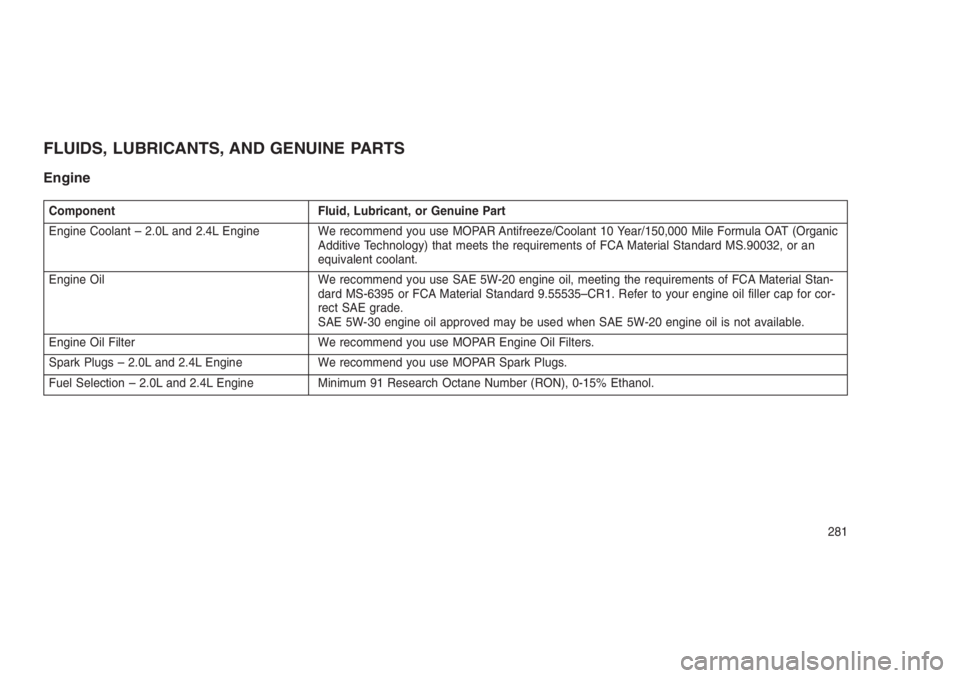
FLUIDS, LUBRICANTS, AND GENUINE PARTS
Engine
Component Fluid, Lubricant, or Genuine Part
Engine Coolant – 2.0L and 2.4L Engine We recommend you use MOPAR Antifreeze/Coolant 10 Year/150,000 Mile Formula OAT (Organic
Additive Technology) that meets the requirements of FCA Material Standard MS.90032, or an
equivalent coolant.
Engine Oil We recommend you use SAE 5W-20 engine oil, meeting the requirements of FCA Material Stan-
dard MS-6395 or FCA Material Standard 9.55535–CR1. Refer to your engine oil filler cap for cor-
rect SAE grade.
SAE 5W-30 engine oil approved may be used when SAE 5W-20 engine oil is not available.
Engine Oil Filter We recommend you use MOPAR Engine Oil Filters.
Spark Plugs – 2.0L and 2.4L Engine We recommend you use MOPAR Spark Plugs.
Fuel Selection – 2.0L and 2.4L Engine Minimum 91 Research Octane Number (RON), 0-15% Ethanol.
281
Page 288 of 332
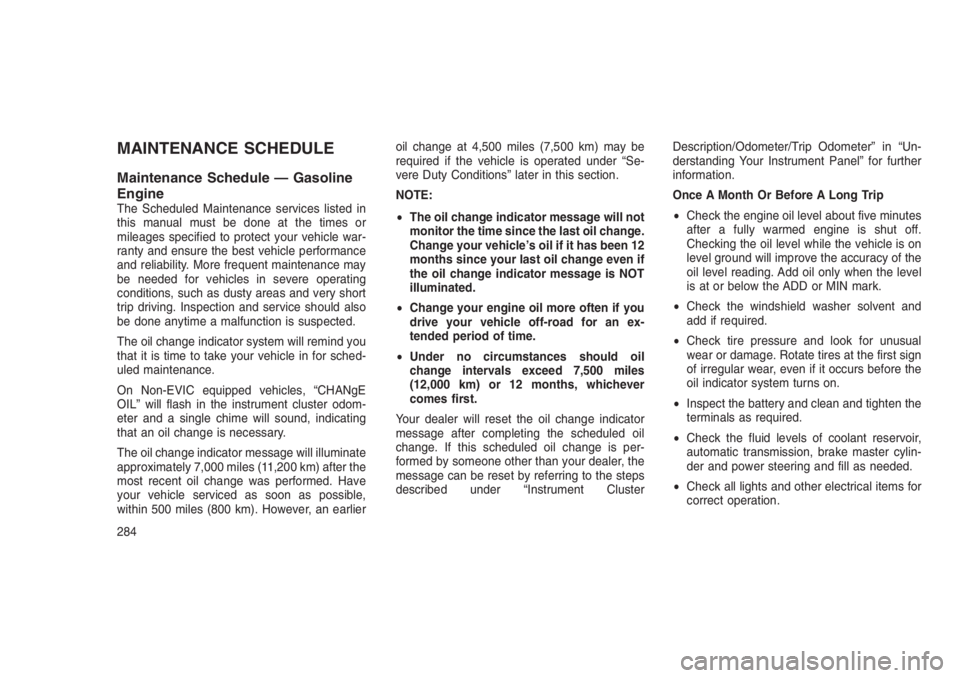
MAINTENANCE SCHEDULE
Maintenance Schedule — Gasoline
Engine
The Scheduled Maintenance services listed in
this manual must be done at the times or
mileages specified to protect your vehicle war-
ranty and ensure the best vehicle performance
and reliability. More frequent maintenance may
be needed for vehicles in severe operating
conditions, such as dusty areas and very short
trip driving. Inspection and service should also
be done anytime a malfunction is suspected.
The oil change indicator system will remind you
that it is time to take your vehicle in for sched-
uled maintenance.
On Non-EVIC equipped vehicles, “CHANgE
OIL” will flash in the instrument cluster odom-
eter and a single chime will sound, indicating
that an oil change is necessary.
The oil change indicator message will illuminate
approximately 7,000 miles (11,200 km) after the
most recent oil change was performed. Have
your vehicle serviced as soon as possible,
within 500 miles (800 km). However, an earlieroil change at 4,500 miles (7,500 km) may be
required if the vehicle is operated under “Se-
vere Duty Conditions” later in this section.
NOTE:
•The oil change indicator message will not
monitor the time since the last oil change.
Change your vehicle’s oil if it has been 12
months since your last oil change even if
the oil change indicator message is NOT
illuminated.
•Change your engine oil more often if you
drive your vehicle off-road for an ex-
tended period of time.
•Under no circumstances should oil
change intervals exceed 7,500 miles
(12,000 km) or 12 months, whichever
comes first.
Your dealer will reset the oil change indicator
message after completing the scheduled oil
change. If this scheduled oil change is per-
formed by someone other than your dealer, the
message can be reset by referring to the steps
described under “Instrument ClusterDescription/Odometer/Trip Odometer” in “Un-
derstanding Your Instrument Panel” for further
information.
Once A Month Or Before A Long Trip
•Check the engine oil level about five minutes
after a fully warmed engine is shut off.
Checking the oil level while the vehicle is on
level ground will improve the accuracy of the
oil level reading. Add oil only when the level
is at or below the ADD or MIN mark.
•Check the windshield washer solvent and
add if required.
•Check tire pressure and look for unusual
wear or damage. Rotate tires at the first sign
of irregular wear, even if it occurs before the
oil indicator system turns on.
•Inspect the battery and clean and tighten the
terminals as required.
•Check the fluid levels of coolant reservoir,
automatic transmission, brake master cylin-
der and power steering and fill as needed.
•Check all lights and other electrical items for
correct operation.
284
Page 322 of 332
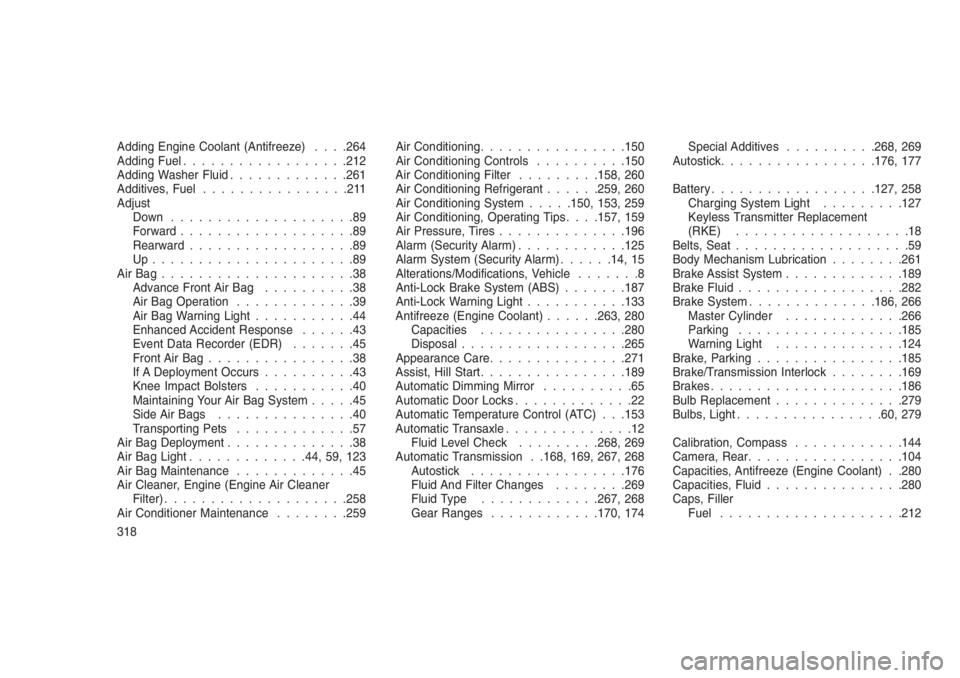
Adding Engine Coolant (Antifreeze). . . .264
Adding Fuel..................212
Adding Washer Fluid.............261
Additives, Fuel................211
Adjust
Down....................89
Forward...................89
Rearward..................89
Up......................89
AirBag.....................38
Advance Front Air Bag..........38
Air Bag Operation.............39
Air Bag Warning Light...........44
Enhanced Accident Response......43
Event Data Recorder (EDR).......45
Front Air Bag................38
If A Deployment Occurs..........43
Knee Impact Bolsters...........40
Maintaining Your Air Bag System.....45
Side Air Bags...............40
Transporting Pets.............57
Air Bag Deployment..............38
Air Bag Light.............44, 59, 123
Air Bag Maintenance.............45
Air Cleaner, Engine (Engine Air Cleaner
Filter)....................258
Air Conditioner Maintenance........259Air Conditioning................150
Air Conditioning Controls..........150
Air Conditioning Filter.........158, 260
Air Conditioning Refrigerant......259, 260
Air Conditioning System.....150, 153, 259
Air Conditioning, Operating Tips. . . .157, 159
Air Pressure, Tires..............196
Alarm (Security Alarm)............125
Alarm System (Security Alarm)......14, 15
Alterations/Modifications, Vehicle.......8
Anti-Lock Brake System (ABS).......187
Anti-Lock Warning Light...........133
Antifreeze (Engine Coolant)......263, 280
Capacities................280
Disposal..................265
Appearance Care...............271
Assist, Hill Start................189
Automatic Dimming Mirror..........65
Automatic Door Locks.............22
Automatic Temperature Control (ATC) . . .153
Automatic Transaxle..............12
Fluid Level Check.........268, 269
Automatic Transmission . .168, 169, 267, 268
Autostick.................176
Fluid And Filter Changes........269
Fluid Type.............267, 268
Gear Ranges............170, 174Special Additives..........268, 269
Autostick.................176, 177
Battery..................127, 258
Charging System Light.........127
Keyless Transmitter Replacement
(RKE)...................18
Belts, Seat...................59
Body Mechanism Lubrication........261
Brake Assist System.............189
Brake Fluid..................282
Brake System..............186, 266
Master Cylinder.............266
Parking..................185
Warning Light..............124
Brake, Parking................185
Brake/Transmission Interlock........169
Brakes.....................186
Bulb Replacement..............279
Bulbs, Light................60, 279
Calibration, Compass............144
Camera, Rear.................104
Capacities, Antifreeze (Engine Coolant) . .280
Capacities, Fluid...............280
Caps, Filler
Fuel....................212
318
Page 323 of 332
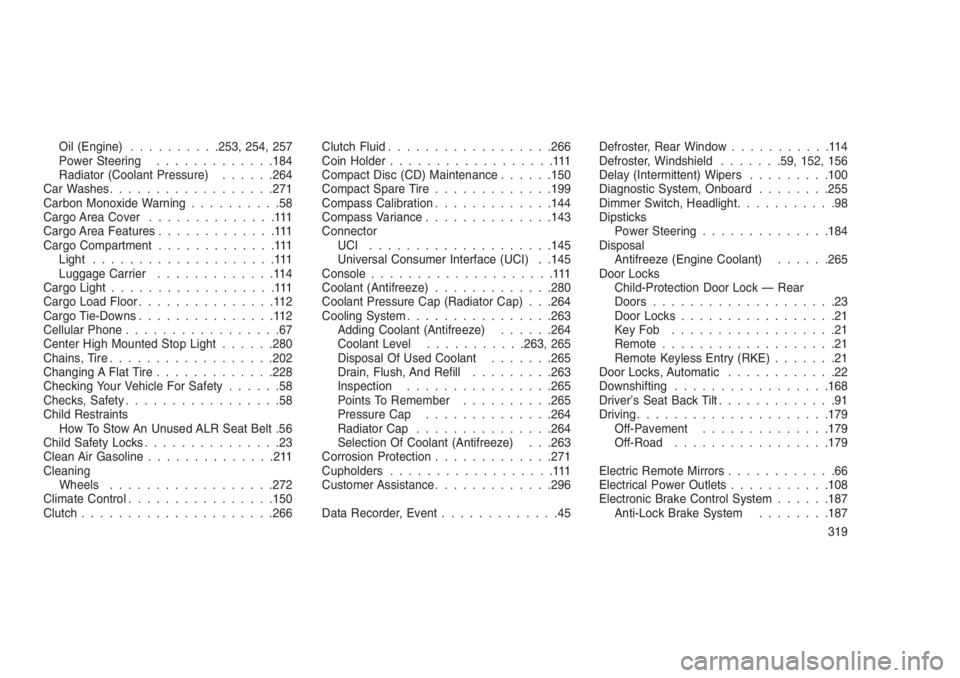
Oil (Engine)..........253, 254, 257
Power Steering.............184
Radiator (Coolant Pressure)......264
Car Washes..................271
Carbon Monoxide Warning..........58
Cargo Area Cover..............111
Cargo Area Features.............111
Cargo Compartment.............111
Light....................111
Luggage Carrier.............114
Cargo Light..................111
Cargo Load Floor...............112
Cargo Tie-Downs...............112
Cellular Phone.................67
Center High Mounted Stop Light......280
Chains, Tire..................202
Changing A Flat Tire.............228
Checking Your Vehicle For Safety......58
Checks, Safety.................58
Child Restraints
How To Stow An Unused ALR Seat Belt .56
Child Safety Locks...............23
Clean Air Gasoline..............211
Cleaning
Wheels..................272
Climate Control................150
Clutch.....................266Clutch Fluid..................266
Coin Holder..................111
Compact Disc (CD) Maintenance......150
Compact Spare Tire.............199
Compass Calibration.............144
Compass Variance..............143
Connector
UCI ....................145
Universal Consumer Interface (UCI) . .145
Console....................111
Coolant (Antifreeze).............280
Coolant Pressure Cap (Radiator Cap) . . .264
Cooling System................263
Adding Coolant (Antifreeze)......264
Coolant Level...........263, 265
Disposal Of Used Coolant.......265
Drain, Flush, And Refill
.........263
Inspection................265
Points To Remember..........265
Pressure Cap..............264
Radiator Cap...............264
Selection Of Coolant (Antifreeze) . . .263
Corrosion Protection.............271
Cupholders..................111
Customer Assistance.............296
Data Recorder, Event.............45Defroster, Rear Window...........114
Defroster, Windshield.......59, 152, 156
Delay (Intermittent) Wipers.........100
Diagnostic System, Onboard........255
Dimmer Switch, Headlight...........98
Dipsticks
Power Steering..............184
Disposal
Antifreeze (Engine Coolant)......265
Door Locks
Child-Protection Door Lock — Rear
Doors....................23
Door Locks.................21
KeyFob ..................21
Remote...................21
Remote Keyless Entry (RKE).......21
Door Locks, Automatic............22
Downshifting.................168
Driver’s Seat Back Tilt.............91
Driving.....................179
Off-Pavement..............179
Off-Road.................179
Electric Remote Mirrors............66
Electrical Power Outlets...........108
Electronic Brake Control System......187
Anti-Lock Brake System........187
319
Page 324 of 332
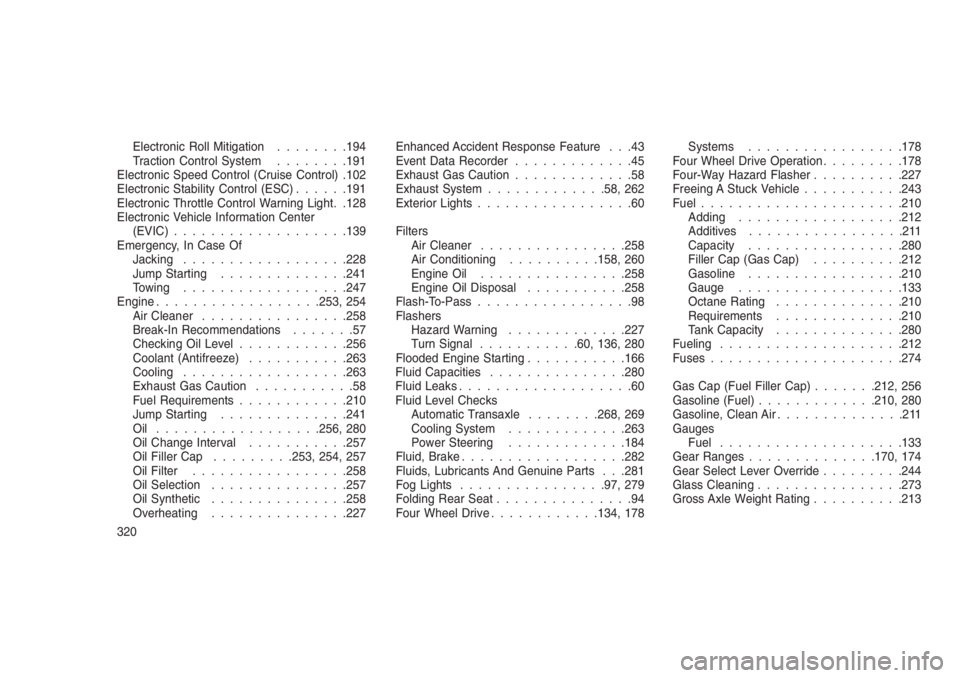
Electronic Roll Mitigation........194
Traction Control System........191
Electronic Speed Control (Cruise Control) .102
Electronic Stability Control (ESC)......191
Electronic Throttle Control Warning Light. .128
Electronic Vehicle Information Center
(EVIC)...................139
Emergency, In Case Of
Jacking..................228
Jump Starting..............241
Towing..................247
Engine..................253, 254
Air Cleaner................258
Break-In Recommendations.......57
Checking Oil Level............256
Coolant (Antifreeze)...........263
Cooling..................263
Exhaust Gas Caution...........58
Fuel Requirements............210
Jump Starting..............241
Oil ..................256, 280
Oil Change Interval...........257
Oil Filler Cap.........253, 254, 257
Oil Filter.................258
Oil Selection...............257
Oil Synthetic...............258
Overheating...............227Enhanced Accident Response Feature . . .43
Event Data Recorder.............45
Exhaust Gas Caution.............58
Exhaust System.............58, 262
Exterior Lights.................60
Filters
Air Cleaner................258
Air Conditioning..........158, 260
Engine Oil................258
Engine Oil Disposal...........258
Flash-To-Pass.................98
Flashers
Hazard Warning.............227
Turn Signal...........60, 136, 280
Flooded Engine Starting...........166
Fluid Capacities...............280
Fluid Leaks...................60
Fluid Level Checks
Automatic Transaxle........268, 269
Cooling System.............263
Power Steering.............184
Fluid, Brake..................282
Fluids, Lubricants And Genuine Parts . . .281
Fog Lights................97, 279
Folding Rear Seat...............94
Four Wheel Drive............134, 178Systems.................178
Four Wheel Drive Operation.........178
Four-Way Hazard Flasher..........227
Freeing A Stuck Vehicle...........243
Fuel......................210
Adding..................212
Additives.................211
Capacity.................280
Filler Cap (Gas Cap)..........212
Gasoline.................210
Gauge..................133
Octane Rating..............210
Requirements..............210
Tank Capacity..............280
Fueling....................212
Fuses.....................274
Gas Cap (Fuel Filler Cap).......212, 256
Gasoline (Fuel).............210, 280
Gasoline, Clean Air..............211
Gauges
Fuel....................133
Gear Ranges..............170, 174
Gear Select Lever Override.........244
Glass Cleaning................273
Gross Axle Weight Rating..........213
320
Page 327 of 332
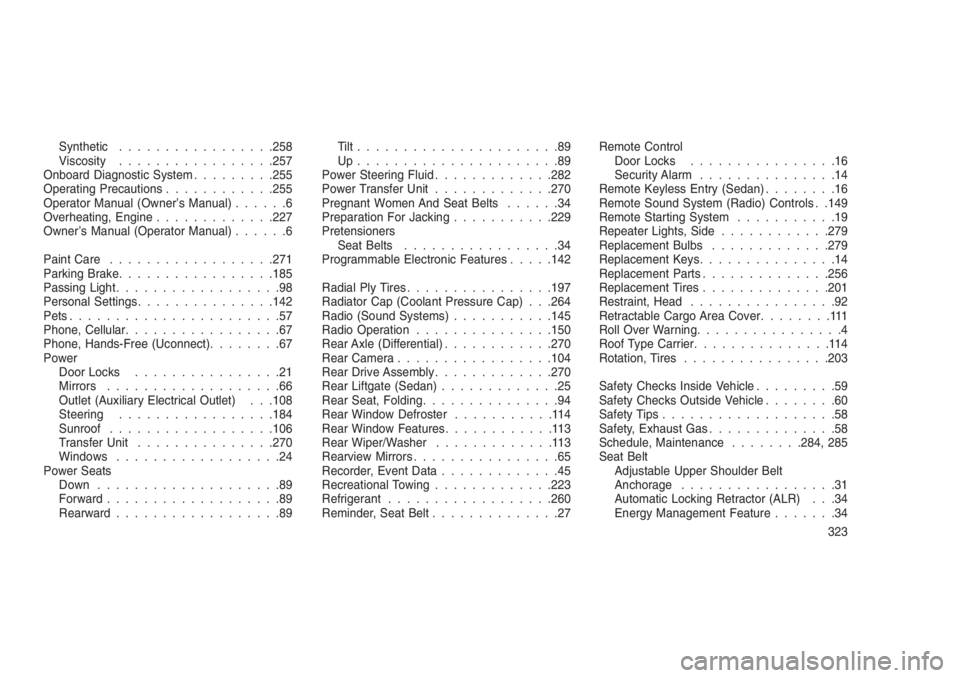
Synthetic.................258
Viscosity.................257
Onboard Diagnostic System.........255
Operating Precautions............255
Operator Manual (Owner’s Manual)......6
Overheating, Engine.............227
Owner’s Manual (Operator Manual)......6
Paint Care..................271
Parking Brake.................185
Passing Light..................98
Personal Settings...............142
Pets.......................57
Phone, Cellular.................67
Phone, Hands-Free (Uconnect)........67
Power
Door Locks................21
Mirrors...................66
Outlet (Auxiliary Electrical Outlet) . . .108
Steering.................184
Sunroof..................106
Transfer Unit...............270
Windows..................24
Power Seats
Down....................89
Forward...................89
Rearward..................89Tilt......................89
Up......................89
Power Steering Fluid.............282
Power Transfer Unit.............270
Pregnant Women And Seat Belts......34
Preparation For Jacking...........229
Pretensioners
Seat Belts.................34
Programmable Electronic Features.....142
Radial Ply Tires................197
Radiator Cap (Coolant Pressure Cap) . . .264
Radio (Sound Systems)...........145
Radio Operation...............150
Rear Axle (Differential)............270
Rear Camera.................104
Rear Drive Assembly.............270
Rear Liftgate (Sedan).............25
Rear Seat, Folding...............94
Rear Window Defroster...........114
Rear Window Features............113
Rear Wiper/Washer.............113
Rearview Mirrors................65
Recorder, Event Data.............45
Recreational Towing.............223
Refrigerant..................260
Reminder, Seat Belt..............27Remote Control
Door Locks................16
Security Alarm...............14
Remote Keyless Entry (Sedan)........16
Remote Sound System (Radio) Controls . .149
Remote Starting System...........19
Repeater Lights, Side............279
Replacement Bulbs.............279
Replacement Keys...............14
Replacement Parts..............256
Replacement Tires..............201
Restraint, Head................92
Retractable Cargo Area Cover........111
Roll Over Warning................4
Roof Type Carrier...............114
Rotation, Tires................203
Safety Checks Inside Vehicle.........59
Safety Checks Outside Vehicle........60
Safety Tips...................58
Safety, Exhaust Gas..............58
Schedule, Maintenance........284, 285
Seat Belt
Adjustable Upper Shoulder Belt
Anchorage.................31
Automatic Locking Retractor (ALR) . . .34
Energy Management Feature.......34
323